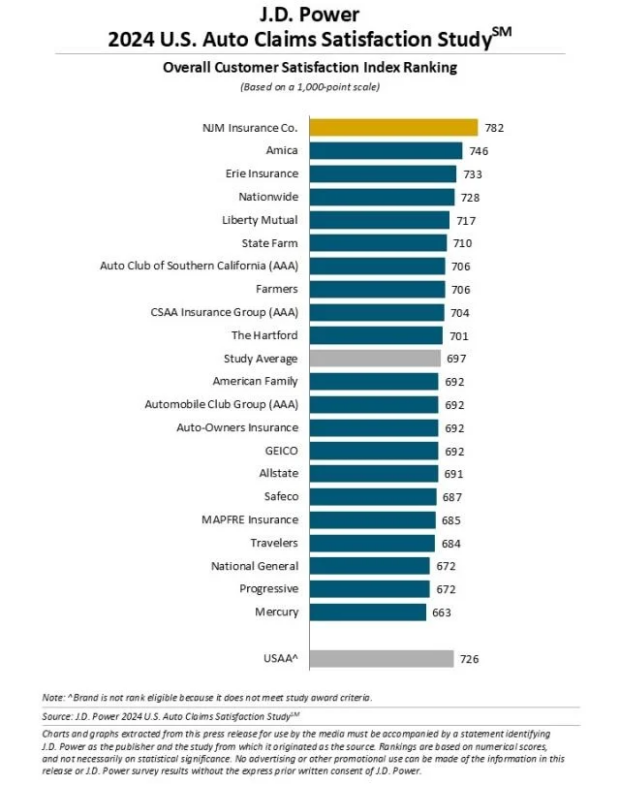Rising auto insurance premiums and long cycle times have been the bane of insurers for some time. A new report, “U.S. Auto Claims Satisfaction Study” from J.D. Power, finds that the average repair cycle time for claims filed has declined by five days to 18.9 days.
Unfortunately, the study also found that average repair cost has risen 26 percent in the past two years, with premiums following suit, rising 15 percent during the past year.
Redesigned this year, the study measures customer experience across eight core dimensions (in order of importance: trust; fairness of settlement; time to settle claim; people; communication; ease of resolving claim; ease of starting claim; and digital channels) for those who file a claim with their insurer (excluding glass/windshield loss, roadside assistance, and vehicle theft).
Rising insurance costs continues to hurt overall satisfaction.
Overall, 48 percent of study respondents experienced a premium increase during the past 12 months.
Satisfaction is particularly low among those who incurred increases prior to their claim. The study shows that these customers were more likely to have an issue—such as communication with the insurer not being very easy or timing expectations not being managed—and thus they didn’t feel more at ease after submitting their claim.
Nearly half of those increases were attributable to claims.
Compared with those customers who did not have an increase, satisfaction scores fall more than 100 points (on a 1,000-point scale) following a claim-related rate increase.
The study found the negative effect is most pronounced among Baby Boomers and Pre-Boomers, with a 178-point decrease in trust following a claim-related rate increase.
The data shows digital claims processing can help with satisfaction, JD Power said, but not for all customers, specifically older customers, and how good communication continues to be important for satisfaction with the claims experience.
Insurers focused on improving mobile apps are seeing the payoff, the study found.
For the past three years, claims filed via call centers or agents outperformed digital channels, but now digital is receiving higher scores with mobile apps achieving the highest scores.
In addition, satisfaction is higher among those who stay in the app to submit photos and receive status updates (775) than for all other digital experiences. However, this group comprises only 13 percent of customers.
Boomers and Pre-Boomers are still hesitant to adopt digital processes, with 32 percent stating they disagree with being comfortable using digital tools for the entire claim.
Customers also rate digital channels lower than speaking with someone if they have a specific question. As a result, generational differences and the types of tasks being performed are still affecting digital experiences, the data showed.
The No. 1 key performance indicator in the study is to ensure that communicating with insurer reps is very easy: being accessible; responding in a timely fashion; reps providing consistent service; managing timing expectations; and providing options for proactive updates are all critical elements of communication throughout a claim.
This is another area, said J.D. Power, where digital tools play a key role in customers’ ability to access information and stay informed.
“The claims process is the moment of truth for auto insurance customers, so when they experience rate increases and then have a claim with longer-than-expected repair times and other inconveniences, their overall trust in the brand is greatly diminished,” said Mark Garrett, director of global insurance intelligence at J.D. Power. “In fact, 80 percent of auto insurance customers who have poor claims experiences have already left or say they plan to leave that carrier. That makes this year’s significant improvement in repair cycle times very good news for insurers and their customers. However, premium increases have created a new challenge for insurers as trust is eroding and affecting the way customers view their claims. There are still many challenges the industry needs to navigate to maintain customer loyalty.”

NJM Insurance Co. ranked highest in overall customer satisfaction with a score of 782. Amica (746) ranked second and Erie Insurance (733) ranked third.
The U.S. Auto Claims Satisfaction Study was redesigned for 2024. Scores are not comparable year over year with previous studies. The 2024 study is based on responses from 9,725 auto insurance customers who settled a claim within the past nine months prior to participating in the survey. It measures customer experience across eight core dimensions (in order of importance): trust; fairness of settlement; time to settle claim; people; communication; ease of resolving claim; ease of starting claim; and digital channels. The study excludes claimants whose vehicle incurred only glass/windshield damage or was stolen, or who only filed a roadside assistance claim. The study was fielded from October 2023 through August 2024.





















 The Hardest Part of Innovation in Insurance Isn’t Technology; It’s Culture
The Hardest Part of Innovation in Insurance Isn’t Technology; It’s Culture  The Latest Launches from Allstate, WTW, Whisker Labs
The Latest Launches from Allstate, WTW, Whisker Labs  Truckers Who Fail English Tests Are Pulled Off Roads in Crackdown
Truckers Who Fail English Tests Are Pulled Off Roads in Crackdown  Examining 5 Key Factors Fueling MGA Growth—and Emerging Challenges Ahead
Examining 5 Key Factors Fueling MGA Growth—and Emerging Challenges Ahead 




